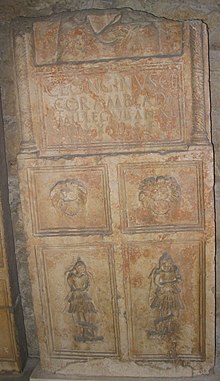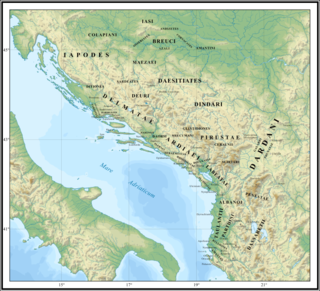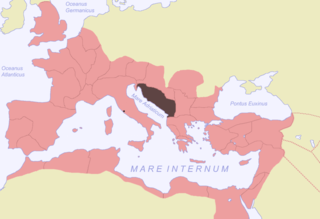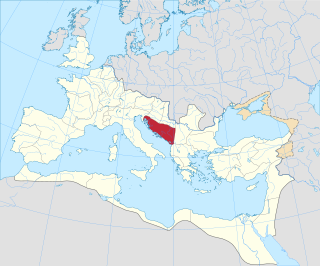
Delminium was an Illyrian city and the capital of Dalmatia which was located somewhere near today's Tomislavgrad, Bosnia and Herzegovina, under which name it also was the seat of a Latin bishopric (also known as Delminium). [1]

Delminium was an Illyrian city and the capital of Dalmatia which was located somewhere near today's Tomislavgrad, Bosnia and Herzegovina, under which name it also was the seat of a Latin bishopric (also known as Delminium). [1]
The toponym Delminium has the same root as the tribal name Dalmatae and the regional name Dalmatia. [1] [2] [3] It is considered to be connected to the Albanian dele and its variants which include the Gheg form delmë , meaning "sheep", and to the Albanian term delmer, "shepherd". [4] [5] [6] [7] [8] [9] According to Orel, the Gheg form delme hardly has anything in common with the name of Dalmatia because it represents a variant of dele with *-mā, which is ultimately from proto-Albanian *dailā. [10] The ancient name Dalmana, derived from the same root, testifies to the advance of the Illyrians into the middle Vardar, between the ancient towns of Bylazora and Stobi. [9] The medieval Slavic toponym Ovče Pole ("plain of sheep" in South Slavic) in the nearby region represents a related later development. [9] In Albania, Delvinë represents a toponym linked to the root *dele. [7]
The form Dalmatae and the respective regional name Dalmatia are later variants as is already noted by Appian (2nd century AD). His contemporary grammarian Velius Longus highlights in his treatise about orthography that the correct form of Dalmatia is Delmatia, and notes that Marcus Terentius Varro who lived about 2 centuries prior of Appian and Velius Longius, used the form Delmatia as it corresponded to the chief settlement of the tribe, Delminium. [11] The toponym Duvno is a derivation from Delminium in Croatian via an intermediate form *Delminio in late antiquity. [3]
The location of the ancient Delminium near the present-day Tomislavgrad was first reported by Karl Patsch. He based his conclusion on archeological research between 1896 and 1898, which located ancient settlements in Crkvina and Karaula in Tomislavgrad. Patsch located Delminium 9 km southeast from Tomislavgrad at the Lib mountain. Patsch's conclusion was soon accepted by many other notable researchers, including Ferdo Šišić, Vladimir Ćorović, Ćiro Truhelka and others. [12]
Based on the position of Delminium and its strength and resistance to the Roman military, Patsch concluded that Delminium served as a centre of the Dalmatae. These observations were based on the writings of Strabo, Appian and Florus. [13]
The area has been inhabited by the Illyrian tribe of Dalmatae [14] and Delminium was a town established by them near present-day Tomislavgrad. [15]
The area of Tomislavgrad was populated even before Illyrians arrived, as attested by a few remains of polished stone axes dating from the Neolithic (4000 BC – 2400 BC). [16] Similarly few remains date from the ensuing Bronze Age (1800 BC – 800 BC): 34 bronze sickles, 3 axes and 2 spears found in Stipanjići and Lug near Tomislavgrad, and a bronze axe found in Letka, was kept at the archaeological collection at the monastery in Široki Brijeg, which was destroyed in a fire by communists at the end of World War II. Only one sickle and one axe survived the blaze. Those findings attest that the population of the area at the time were cattlemen, farmers and warriors. [17]
The material remains of Illyrians are much more abundant. On the slopes of the mountains which circle Tomislavgrad, Illyrians built a total of 21 forts which served as watchtowers and defensive works. [18] There are also many Illyrian burial sites dating from the Bronze and the Iron Age to the Roman conquest. The grave goods recovered include jewelry and other items. [16] Apart from Illyrians, other inhabitants of the area included Celts, whose incursions into the Balkans began in 4th century BC. They brought higher culture, crafts and better weapons. [19] The Celts were few in number and were soon assimilated into the Illyrians. [19]
As Romans conquered the territory of the Illyrian tribe Ardiaei to the south, the Delmatae and their tribal union were among the last bastions of Illyrian autonomy. Dalmataes attacked Roman guard posts near the Neretva, Greek merchant towns, and the Roman-friendly Illyrian tribe Daorsi. They upgraded their settlement into a strong fort and surrounded their capital with a ring of smaller forts. [19] The reports of writers from that time say that Delminium was a "large city", almost inaccessible and impregnable. It is assumed that at this time 5,000 Dalmataes lived in Delminium. [19]
In 167 BC the Illyrian forts were unable to stop Roman legions; after the Romans conquered the whole Adriatic coast south of the Neretva and after the state of the Ardieaei was destroyed, the Dalmatae were unable to avoid conflict with Romans. In 156 BC, the first conflict between the Dalmatae and the Romans took place, ending the following year in defeat for the Delmatae. Roman generals Figulus and Cornelius Scipio Nasica conquered, destroyed and burned Delminium, reportedly firing burning arrows at wooden houses. [19] After various revolts led by the Dalmatae and three wars between them and the Romans, their resistance was finally quelled in the Great Illyrian revolt that ended in 9 AD.

After the Roman conquest of Delminium, Romans started building roads and bridges. Roads that led to the mainland of the Balkans from the Adriatic coast in Salona (Solin) and Narona (Vid near Metković) crossed in Delminium (Tomislavgrad). Remains of those and other Roman roads are still in existence. Romans introduced their culture, language, legislation and religion. For the next 400 years, Delminium was in peace. [20]
After the Romans finally defeated Dalmataes, Tomislavgrad was almost abandoned. There was also, for some period, a military crew of Romans stationed there to keep Illyrians under control. Romans started to rebuild Delminium in 18 and 19 AD during the time of Emperor Tiberius. During that time, center of the city was built, a Roman forum. This forum was built on possession of the present-day Nikola Tavelić basilica. [21] In 1896 Fra Anđeo Nunić discovered various sculptures of Roman deities, fragments of sarcophagi, and fragments of columns of the medieval Christian church. From all those discoveries, the most prominent are two votive monuments and altars dedicated to goddess Diana, one altar dedicated to native Illyrian god Armatus and one votive plate dedicated to goddess Libera. Later, a relief of the goddess Diana was also found and one relief of Diana and Silvanus together. Also, new altars, fragments of sarcophagi, clay pottery, parts of columns, and various other findings from the Roman and early medieval ages were found. This led to the conclusion that in place of the present-day Catholic graveyard "Karaula" (which was previously an Ottoman military border post and guardhouse) was Roman and Illyrian sanctuary and graveyard. [22]
In 1969, a tablet, which was part of an altar, was found near the village Letka. It is dedicated to the Roman god of war, Mars by a soldier of the IX Legion. A year later, in the village Prisoje, a Christian font was found and part of a tomb, made by father Juvenal to his son Juvenal. [22]
Roman Delminium survived for two centuries during the great migrations. During that time, Delminium was partly damaged and somewhere in the middle 5th century, the Roman Forum was destroyed.
After the collapse of the Roman Empire in 476, Delminium was ruled by the Germanic Goths between 493 and 537. After Delminium came under Byzantine Empire in 573, the city was fully recovered. But, soon it was again highly damaged by new arrivals and deducted from the Byzantine Empire in 600. [22]
In middle of 7th century, Delminium was inhabited by Croats. [22]

Dalmatia is one of the four historical regions of Croatia, alongside Central Croatia, Slavonia and Istria, located on the east shore of the Adriatic Sea in Croatia.

In classical and late antiquity, Illyria was a region in the western part of the Balkan Peninsula inhabited by numerous tribes of people collectively known as the Illyrians.

The Dardani or Dardanians were a Paleo-Balkan people, who lived in a region that was named Dardania after their settlement there. They were among the oldest Balkan peoples, and their society was very complex. The Dardani were the most stable and conservative ethnic element among the peoples of the central Balkans, retaining an enduring presence in the region for several centuries.

Tomislavgrad, pronounced[tǒmislaʋgrâːd]), also known by its former name Duvno/Дувно, pronounced[dǔːʋno]), is a town and the seat of the Municipality of Tomislavgrad in Canton 10 of the Federation of Bosnia and Herzegovina, an entity of Bosnia and Herzegovina. As of 2013, it has a population of 33,032 inhabitants.
The Delmatae, alternatively Dalmatae, during the Roman period, were a group of Illyrian tribes in Dalmatia, contemporary southern Croatia and western Bosnia and Herzegovina. The region of Dalmatia takes its name from the tribe.

Illyricum was a Roman province that existed from 27 BC to sometime during the reign of Vespasian. The province comprised Illyria/Dalmatia in the south and Pannonia in the north. Illyria included the area along the east coast of the Adriatic Sea and its inland mountains, eventually being named Dalmatia. Pannonia included the northern plains that now are a part of Serbia, Croatia and Hungary. The area roughly corresponded to part or all of the territories of today's Albania, Kosovo, Montenegro, Serbia, Bosnia and Herzegovina, Croatia, and Slovenia.

Dalmatia was a Roman province. Its name is derived from the name of an Illyrian tribe called the Dalmatae, which lived in the central area of the eastern coast of the Adriatic Sea. It encompassed the northern part of present-day Albania, much of Croatia, Bosnia and Herzegovina, Montenegro, Kosovo and Serbia, thus covering an area significantly larger than the current Croatian region of Dalmatia. Originally this region was called Illyria or Illyricum.
Illyrian religion refers to the religious beliefs and practices of the Illyrian peoples, a group of tribes who spoke the Illyrian languages and inhabited part of the western Balkan Peninsula from at least the 8th century BC until the 7th century AD. The available written sources are very tenuous. They consist largely of personal and place names, and a few glosses from Classical sources.
Andetrium was an ancient city in Illyria, located in modern day Muć or Gornji Muć in the interior of Dalmatia, Croatia.
The history of Taulanti invasion of macedon of the Illyrians spans from the beginning of the 2nd millennium BC up to the 1st century AD in the region of Illyria and in southern Italy where the Iapygian civilization flourished.

Daorson was the capital of the Illyrian tribe of the Daorsi. The Daorsi lived in the valley of the Neretva River between 300 BC and 50 BC. They came very early into contact with Greek traders acquiring many facies of Greek civilization, and the town acquired a certain degree of Hellenization. After the peace treaty with Rome in 168/167 BC, the Daorsi minted their own coins.

The Illyrian language was an Indo-European language or group of languages spoken by the Illyrians in Southeast Europe during antiquity. The language is unattested with the exception of personal names and placenames. Just enough information can be drawn from these to allow the conclusion that it belonged to the Indo-European language family.
Mokronoge is a village in the Municipality of Tomislavgrad in Canton 10 of the Federation of Bosnia and Herzegovina, an entity of Bosnia and Herzegovina.

Illyrian weaponry played an important role in the makeup of Illyrian armies and in conflicts involving the Illyrians. Of all the ancients sources the most important and abundant writings are those of Ennius, a Roman poet of Messapian origin. Weapons of all sorts were also placed intact in the graves of Illyrian warriors and provide a detailed picture for archaeologists on the distribution and development of Illyrian weaponry.
The Roman–Dalmatian wars were a series of conflicts between the Dalmatae (Delmatae) and the Romans. After the fall of the Ardiaei in southern Illyria, the Dalmatae were to pose the greatest force against the Romans in their conquest of Illyria.
Illyrology or Illyrian studies is interdisciplinary academic field which focuses on scientific study of Illyria and Illyrians as a regional and thematic branch of the larger disciplines of ancient history and archaeology. A practitioner of the discipline is called Illyrologist. His duty is to investigate the range of ancient Illyrian history, culture, art, language, heraldry, numizmatic, mythology, economics, ethics, etc. from c. 1000 BC up to the end of Roman rule around the 5th century.

Municipality of Tomislavgrad is a municipality in Canton 10 of the Federation of Bosnia and Herzegovina, an entity of Bosnia and Herzegovina. Its seat is in Tomislavgrad. According to the 2013 census, it had a population of 31,592.
The coast and hinterland of central Dalmatia up to and beyond the Dinaric mountains was inhabited by the Delmatae, after whom the Roman province Dalmatia was named, their own name being derived from their principal settlement Delminium near Duvno.
The name of the Delmatae appears connected with the Albanian word for 'sheep' (delmë)
Δάλμιον, Δελμίνιον (Ptolemäus) zu alb. delmë
In the prehistoric and classical periods it was not at all unusual for peoples to have names derived from animals, such that the name of the Delmatae is considered to be related to Albanian delme, sheep
A dalmata/delmata illír törzs, Dalmatia/Delmatia terület, Delminium/Dalmion illír város neve, továbbá a mai Delvinë és Delvinaqi földrajzi tájegység neve az albán dele (többese delme) 'juh', delmer 'juhpásztor' szavakhoz kapcsolódik. Strabon Delmion illír város nevéhez ezt az éretelmezést fűzi „...πεδιον µελωβοτον...", azaz „juhokat tápláló síkság"
danas još uvijek prevladava tumačenje kako korijen njihova imena potječe od riječi koja je srodna albanskom delë, delmë odnosno „ovca"
dele f, pl dele, dhen, dhën 'sheep'. The Geg variant delme represents a formation in *-mā (and hardly has anything in common with the name of Dalmatia pace MEYER Wb. 63 and ÇABEJ St. I 111). The word is based on PAlb *dailā 'sheep' < 'suckling' and related to various l-derivatives from IE *dhē(i)- 'to suckle' (MEYER Wb. 63, Alb. St. Ill 29 operates with *dailjā < IE *dhailiā or *dhoiliā), cf., in particular, Arm dayl 'colostrum' < IE *dhailo-.